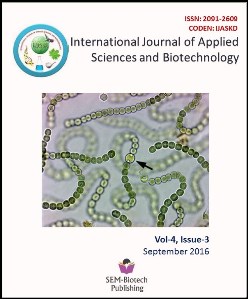Response of Different Cultivars of Radish (Raphanus Sativus L.) to Alternaria Leaf Spot on Seed Production during Winter at Rupandehi Nepal
DOI:
https://doi.org/10.3126/ijasbt.v4i3.15170Keywords:
Radish, Alternaria leaf spot, Screening, Siliqua, AUPDCAbstract
A field experiment was laid out in randomized complete block design with three replications and seven cultivars of Radish as treatments for screening against Alternaria leaf spot for seed production. Disease scoring was done as percentage of leaf area infected on individual plant at 7 and 10 days intervals on leaf and siliqua respectively for 3 times, and disease severity and mean AUDPC were calculated and yield was recorded. Disease symptoms appeared first in Long Chetki 22 DAS and last in Green Neck Miyashige 38 DAS. Maximum mean AUDPC (886.7) on foliage was recorded in Long Chetki while minimum mean AUDPC (690.7) was recorded in Green Neck Miyashige Similarly, highest and lowest total mean AUDPC on siliqua were seen on cultivars 40 Days (1080) and Green Neck Miyashige (66.67) respectively. Highest yield was recorded in Green Neck Miyashige (695.2kg/ha) and lowest yield was recorded in cultivar Long Chetki (477.4kg/hac). Similarly, highest test weight was recorded in cultivar Mino Early (10.28gm) and lowest was recorded in cultivar 40-Days (8.4gm). Cultivar, All Season Green Long failed inflorescence formation hence no evidence of siliqua formation therefore bears value 0 for seed yield. Similarly, highest biomass yield excluding root was found in cultivar Subhra-32 (613.3gm/m2) and lowest biomass yield was recorded in cultivar Green Neck Miyashige (341.7gm/m2). Green Neck Miyashige was found resistant to Alternaria leaf spot disease with maximum seed yield (695.2kg/ha). The cultivars Subhra-32 and 40 days were highly susceptible to Alternaria leaf spot disease with minimum seed yield.
Int J Appl Sci Biotechnol, Vol 4(3): 318-324




